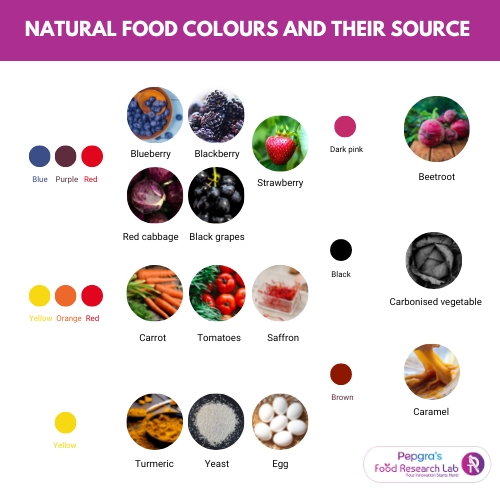
Latest Trends in Food Colour Development | Guires FRL
Introduction
Colour plays a vital role in the perception of food, and food scientists note that it is more important than the texture and flavour of food. That is why food formulation scientists often add food colouring to enhance its overall appeal, for some colour is lost during processing. The substances used to colour food can be natural compounds, synthetic dyes, or complete extracts of herbs or food added to impart colour. The use of food colouring is nothing new to mankind. It has been in use since the historic times. Substances like pomegranates, saffron, turmeric and paprika were used for this purpose.
Natural food colours
According to Rymbai et.al, natural food colours, also called biocolours are those agents that have a property of imparting colour to food. They are obtained primarily from plants, although some have been extracted from algae, insects and animals [1].
Natural food colours are preferred to synthetic food colourings since they can impart as much colour as synthetic colour, are safer and contribute functional properties to food [2].
Some examples of natural food colouring
- Anthocyanins (E163)– Occurring naturally in blackberries, blueberries, black grapes, strawberries and red cabbage, they impart red, purple and deep blue colours to food. The colour they impart depends on the pH of the food, with red being acidic to blue being basic. They are water-soluble and used in jams, confectionery and beverages. They have the advantage of being rich in antioxidants, that aid in cell-defence mechanism.
- Betalains (E162) – It imparts a red or pink colour. It is relatively sensitive to light, heat and oxygen and is therefore used for frozen, dried food and products with a shorter shelf life. The most common source of betalains is beetroot. Other sources of betalains that are explored include cactus pear juice, that can remain stable from pH 3 to 7. Betalains extracted from cactus pear juice possess antioxidant properties. In-vitro studies show that they have a potential to prevent cancer and cardio-vascular disease [3].
- Carmine (E120) – Derived from the female cochineal extract, it gives a bright red colour. It is relatively stable to light, heat and oxygen but unstable in pH. It is used to colour meat, strawberry and cranberry-flavoured products and alcoholic beverages. [1, 3].
- Carotenoids (E160, E161) – Carotenoids are not only widely used in food but are also gaining importance in cosmetic, pharmaceutical and nutraceutical sectors. They are used to colour food with high fatty acid content. They naturally occur in carrots as beta-carotene. Beta- carotene can also be extracted from a fungus named Blakeslea trispora. Astaxanthin is derived from animal sources. Other sources of carotenoids are annatto and saffron. They impart yellow, orange and red colours [3]
- Curcumin (E100) – It is a yellow pigment found in turmeric, which is the most common colouring agent. It is renowned for its medicinal properties [1, 3].
- Riboflavin (E101) – Riboflavin gives a yellow-orange colour to vitamin supplements. It is used as a fortifying agent in cereals and dairy products.
- Carbon-black (E153) – It is formed by carbonizing vegetables and is used to colour cheese, jams, jellies, marmalades in the EU and other countries.
- Caramel (E150) – Caramel is obtained by heating of carbohydrates with an alkali or acid and in some types, ammonium or sulphite or both are added. They are available in four types, with Type I being the lightest to Type IV being the darkest shade. Type IV is commonly used in soft drinks. [3]

Natural Food Colours
Figure 1: Mapping of natural food and their source
Research trends in natural food colour development
i) A review of using hibiscus as a Natural food colours, its extraction techniques and encapsulation of the pigment to prolong its shelf life [4].
ii) Using beta-cyanins extracted from Gomphrena globosa flowers to colour cookies. They have a potential to replace artificial pink colour [5].
iii) Using microbial pigments as a natural colouring agent, exploration of their biological properties, and applications in the pharmaceutical industry [6].
iv) Extraction of carotenoids from papaya- The extraction process was assisted by ultrasound, which could be used as a colourant for sausages [7].
v) Phycocyanin from spirulina- Phycocyanin imparts a blue colour to food and beverages. The colour can be extracted from spirulina in 3 hours at room temperature. [8]
vi) Natural colour extracted from black tea waste- This had a high number of antioxidants which was later used to colour jelly. [9]
vii) Other research areas include the extraction of anthocyanins from passion fruit and raspberries. [9, 10]
Conclusion
Natural food colour has been gaining more popularity recently due to increased awareness. Companies note that although the natural colour is expensive, it is still worth the effort. However, the instability of natural colour poses a challenge that needs to be addressed. Innovations are underway in the discovery of new food colours.
How Food Research Lab can help
We have a team of skilled experts who have helped formulate a new product, or reformulate an existing product or make the product development process more economical. Our expertise also deals with making a food product more attractive by studies on sensory and consumer science.





